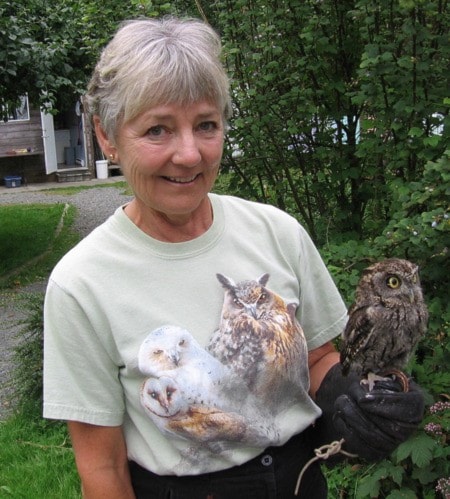The Western screech owl is one of Canada’s 15 species of owl.
They are found from southern Alaska down to the Baja Peninsula.
These are small, nocturnal woodland owls which are found locally in deciduous forests, especially riparian areas alongside rivers and creeks. Usually, they avoid dense coniferous forests, thus avoiding many predators, and take advantage of the open areas where prey is abundant and cavities are available for nesting.
One of the smaller owls, the screech owl stands a mere 21-23 centimetres in height and, in comparison, has a large wingspan of 54-56 centimetres.
When perched, their appearance is round and squat. They puff up their feathers and raise their ear tufts, or they elongate their bodies and squeeze their feathers tight, appearing to be part of the tree.
Screech owls have bright yellow eyes that are highlighted by black facial discs, and their feathers range from reddish brown to grey — depending on their habitat, they may be lighter or darker to blend in with the forest. Eastern species have different colouration phases. The varied pattern and colour of the feathers gives them the perfect camouflage whilst perching in a tree during the daytime.
Nocturnal by nature, screech owls begin to hunt approximately half an hour after sunset; they are patient hunters, conserving energy and only making a move when prey is spotted. They will either target the prey with stealthy silent flight onto the ground or catch prey on the wing, usually in open fields at the forest edge.
These owls are very diverse in their choice of prey, which includes a variety of rodents, insects, moths and butterflies, small birds, frogs and salamanders, snails and even fish, just to name a few. They are formidable predators and think nothing of tackling prey larger than themselves.
One would assume from their name that they “screech,” but this is another misconception. They do not screech, neither do they “hoot” they vocalize with a series of muted “trills or toots,” and if they are really excited, they start to bark.
Mating for life, screech owls will reuse the same nest site for a number of years; usually, they prefer piliated woodpeckers' or Northern flickers' cavities, which are created by the birds as they search for insects. The female produces up the four eggs, and the male will feed her whilst she incubates the eggs.
Like so many areas in British Columbia, the Comox Valley and Campbell River are rapidly expanding and changing the face of the wildlife habitat.
Our increasing traffic and expanding infrastructure is displacing many wildlife species and causing a high mortality on the roads. In addition, the Western screech owl has many natural predators — it is a wonder that they even manage to survive, as they fall prey to six species of larger owls (the barred owl being the worst enemy), raccoons, goshawks and coopers hawks, while their eggs are a delicacy for snakes, squirrels and crows.
It is no surprise that these little owls are a species of concern and are blue-listed in British Columbia, as their habitat and nest sites are disappearing.
Last December, MARS had a Western screech owl sent up from the Pacific Northwest Raptor Center in Duncan, which in turn had received it from Nanaimo, where it had been hit by a car. The owl was initially examined by a local vet, Dr. Ken Langelier, who determined it had sustained a severe eye injury. Unfortunately, it was not taken to the vet for two days.
When it arrived at MARS, the owl was reassessed and diagnosed with severe bruising, swelling, a corneal ulcer and damage to the iris.
Having survived the initial trauma, the owl needed to have daily eye drops into the injured eye, which continued for six months. It was finally obvious that the owl would not be releasable, and due to the fact that they are a species at risk, it was decided to apply and obtain the necessary permits to keep this owl as an ambassador and maybe as part of a future breeding program
Permits are now in place, and Otus is officially “in training” to be part of our educational program.
I have started working with Otus, along with some other handlers, getting the owl used to the presence of people and to wearing jesses on its legs, which secure it on a glove. Hopefully, the owl may be ready to come with me to the classroom later this year.
The story of Otus reinforces the impact we have on wildlife. Please slow down where wildlife signs are posted. Expect deer to jump out at night or especially at dawn and dusk.
If you find injured wildlife, please call us before rescuing or interfering — do not take wildlife home and try to “fix” it, as your kindness can kill it.
Call our toll-free number for immediate assistance or call 250-337-2021 to report injured or orphaned wildlife. More information can be found on our website at www.wingtips.org.
Sandy Fairfield is the educational co-ordinator for the Mountainaire Avian Rescue Society (MARS). The MARS column appears every second Friday.
